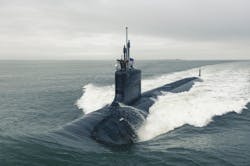Navy taps Applied Physical Sciences for enabling technologies in next-generation submarine propulsion
ARLINGTON, Va. – U.S. military researchers needed a company to develop enabling technologies for next-generation propulsion for crewed submarines and unmanned underwater vehicles (UUVs) that will be quieter and more efficient than ever before. They found their solution from General Dynamics Applied Physical Sciences Corp. in Groton, Conn.
Officials of the U.S. Defense Advanced Research Projects Agency (DARPA) in Arlington, Va., announced a $9.4 million contract to Applied Physical Sciences on 21 April for the Advanced Propulsor, Experimental (APEX) project.
The company will handle areas of interest such as enabling technologies in hydro-dynamics, hydro-acoustics, mechanical engineering, naval submarine architecture, electro-mechanical, and other disciplines. Details of the project are classified.
U.S. military experts constantly are looking for new propulsion technologies for manned and unmanned submersibles to operate in dangerous areas amid ever-more-sophisticated enemy sonar systems.
Today's submarines are quieter than ever before, and are difficult to detect and track even with the most advanced sonar systems. Still, it's a cat-and-mouse game for submarine designers to keep their vessels quiet enough to evade current- and next-generation sonar technologies.
DARPA researchers are asking Applied Physical Sciences for submarine propulsion technologies related to efficiency, signature, mechanical design and limits, and operational considerations.
The project's phase 1A base will last for one year, and will consider theoretical propulsion designs and identify knowledge gaps. Phase 1B option will last for nine months, and will work toward defining one APEX design approach, then refine the design. The three-month phase 1C option will refine the design.
On this contract Applied Physical Sciences will do the work in Groton, Conn.; Concord, Mass.; San Diego; Niskayuna, N.Y.; Arlington and Suffolk, Va.; Cheswick and Imperial, Pa., and should be finished by April 2024.
For more information contact General Dynamics Applied Physical Sciences online at https://aphysci.com, or DARPA at https://www.darpa.mil.
About the Author
John Keller
Editor-in-Chief
John Keller is the Editor-in-Chief, Military & Aerospace Electronics Magazine--provides extensive coverage and analysis of enabling electronics and optoelectronic technologies in military, space and commercial aviation applications. John has been a member of the Military & Aerospace Electronics staff since 1989 and chief editor since 1995.
